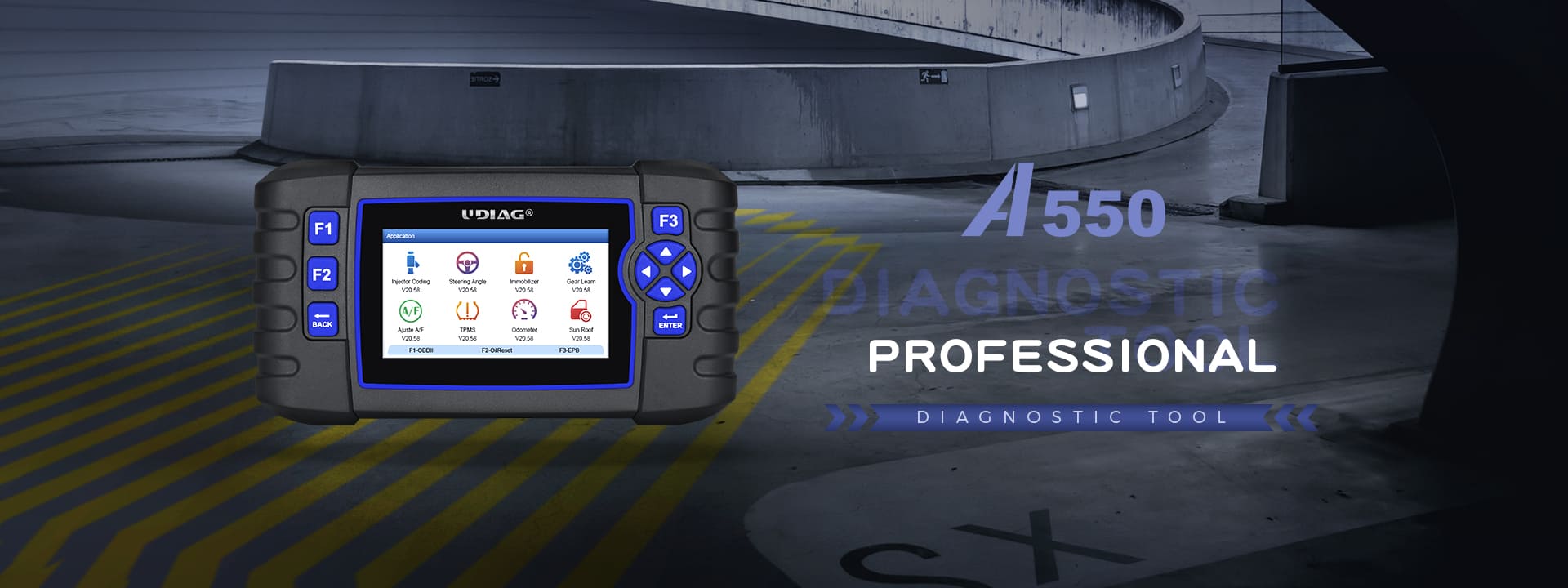What to Do about the P0123 Code
2023-06-06 by UDIAG
The P0123 code, also known as Throttle Position Sensor/Switch A Circuit High Input, holds significant importance in vehicle diagnostics. It serves as an indicator of potential problems related to the throttle position sensor (TPS) or associated circuits. Addressing this code promptly is crucial to ensure optimal vehicle performance and safety. In this essay, we will explore the P0123 code, its causes, symptoms, diagnostic process, and the effectiveness of using UDIAG car scanners for diagnosis.
Understanding the P0123 Code
The P0123 code represents an issue with the TPS or its circuits. The TPS plays a vital role in a vehicle’s functioning, as it monitors the position of the throttle and provides necessary information to the engine control module (ECM). When the P0123 code is triggered, it signifies a potential malfunction or circuit high input in the TPS system.
Common Causes of the P0123 Code
The P0123 code, which indicates a Throttle Position Sensor/Switch A Circuit High Input, can be triggered by several common causes. Understanding these causes is essential for effective diagnosis and resolution of the issue. Here are some of the primary factors that can lead to the P0123 code:
- Faulty Throttle Position Sensor (TPS): A malfunctioning TPS is a common cause of the P0123 code. Over time, the sensor may wear out or become damaged, resulting in inaccurate readings or a complete failure. This can lead to the circuit registering a high input, triggering the P0123 code.
- Wiring or Connection Issues: Damaged, frayed, or loose wiring and connectors can disrupt the signal flow between the TPS and the engine control module (ECM). If the circuit experiences a high input due to poor electrical connections or damaged wiring, the P0123 code may be triggered.
- Intermittent Electrical Problems: In some cases, the P0123 code can occur intermittently due to intermittent electrical problems. These issues may be caused by loose connections, corroded terminals, or short circuits. As a result, the circuit intermittently registers a high input, leading to the code activation.
- Engine Control Module (ECM) Problems: The ECM plays a crucial role in receiving signals from the TPS and controlling the throttle accordingly. If there are problems with the ECM, such as failures, glitches, or software issues, it may not receive accurate data from the TPS, causing the P0123 code to be triggered.
- Mechanical Issues: While less common, mechanical issues within the throttle system can also contribute to the P0123 code. These issues could include binding or sticking throttle components, which can affect the TPS’s ability to provide accurate readings to the ECM.
Symptoms of the P0123 Code
The P0123 code, indicating a Throttle Position Sensor/Switch A Circuit High Input, can manifest through various symptoms that can impact the overall performance of the vehicle. Recognizing these symptoms is crucial for diagnosing the issue accurately. Here are some common symptoms associated with the P0123 code:
- Engine Performance Issues: One of the primary symptoms of the P0123 code is noticeable engine performance problems. This can include rough idling, where the engine may vibrate or exhibit inconsistent RPMs when the vehicle is stationary. Additionally, the engine may experience hesitation or lack of responsiveness during acceleration, making it feel sluggish or unresponsive.
- Stalling: The P0123 code can cause the engine to stall or shut off unexpectedly. This typically occurs when the throttle position readings are inaccurate, leading to incorrect fuel delivery and disrupted engine operation. Stalling can happen while idling, slowing down, or even during normal driving conditions, posing a safety risk.
- Reduced Power and Acceleration: A faulty throttle position sensor can result in reduced power and acceleration capabilities. The engine may struggle to generate sufficient power, causing a noticeable decline in acceleration performance. This can make it challenging to reach higher speeds or overtake vehicles on the road.
- Illuminated Check Engine Light: When the P0123 code is triggered, it activates the check engine light on the vehicle’s dashboard. The light serves as a visual indicator that there is a problem within the throttle position sensor circuit. It’s important not to ignore the illuminated check engine light, as it can signify potential issues that require attention.
- Reduced Fuel Efficiency: The P0123 code can impact the vehicle’s fuel efficiency. When the throttle position sensor provides inaccurate readings, the engine may receive incorrect information about the required fuel-to-air ratio. As a result, the engine may run rich or lean, leading to increased fuel consumption and reduced mileage.
Using UDIAG Car Scanners to Diagnose the P0123 Code
Using UDIAG car scanners for diagnosing the P0123 code, which indicates a Throttle Position Sensor/Switch A Circuit High Input, offers an efficient and accurate approach to identifying and resolving the underlying issue. UDIAG car scanners are powerful tools that provide users with valuable data and diagnostic capabilities. Here’s a step-by-step guide on how to use UDIAG car scanners to diagnose the P0123 code:

- Connecting the UDIAG Car Scanner:
- Locate the OBD-II port in your vehicle.
- Connect the UDIAG car scanner to the OBD-II port by plugging it in firmly.
- Powering On the UDIAG Car Scanner:
- Power on the UDIAG car scanner by pressing the power button or following the instructions.
- Ensure that the scanner has a sufficient power source, whether it is battery-powered or requires an external power supply.
- Retrieving and Interpreting the P0123 Code:
- Access the diagnostic menu on the UDIAG car scanner. The specific steps may vary depending on the scanner’s model and interface.
- Select the option to scan for trouble codes or perform a comprehensive diagnostic scan.
- The scanner will communicate with the vehicle’s ECM and retrieve any stored trouble codes, including the P0123 code.
- Once the code is retrieved, the scanner will display the code on its screen along with a brief description.
- Interpretation and Diagnosis:
- Refer to the scanner’s user manual or built-in code library to interpret the meaning of the P0123 code accurately.
- The interpretation will provide insights into the specific nature of the problem, indicating whether it is related to the throttle position sensor or the associated circuit.
- Take note of any additional information provided by the scanner, such as freeze frame data or live sensor readings, which can further aid in diagnosis.
- Further Diagnostic Steps:
- Depending on the information obtained from the UDIAG car scanner, further diagnostic steps may be necessary.
- These steps may include physical inspection of the throttle position sensor, checking the wiring and connectors, or performing additional tests using multimeters or oscilloscopes.
By utilizing UDIAG car scanners, automotive technicians gain a valuable diagnostic tool for efficiently and accurately retrieving and interpreting the P0123 code. The scanner’s ability to communicate with the vehicle’s ECM and provide real-time data aids in pinpointing the underlying issue, enabling effective repairs and resolution of the P0123 code.
Preventive Measures for the P0123 Code
To minimize the occurrence of the P0123 code and ensure the long-term health of your vehicle’s throttle position sensor (TPS) and related circuits, it is essential to follow preventive measures. By taking proactive steps, you can reduce the likelihood of encountering the P0123 code and other potential issues. Here are some preventive measures to consider:
- Regular Maintenance:
- Schedule routine inspections and servicing of your vehicle as recommended by the manufacturer. This allows professional technicians to identify and address potential problems before they escalate.
- Ensure that the TPS and its connections are inspected during regular maintenance. This includes checking for any signs of wear, damage, or loose connections.
- Proper Driving Habits:
- Maintain a steady throttle control while driving. Avoid sudden and aggressive acceleration or deceleration, as this can place unnecessary strain on the TPS and related components.
- Drive smoothly and avoid excessive idling. Consistent and moderate driving habits can help prolong the lifespan of the TPS and reduce the likelihood of encountering issues.
- Quality Parts and Repairs:
- When replacing parts, such as the TPS or wiring, choose genuine or high-quality components. These parts are designed to meet the specific requirements of your vehicle and offer better reliability and longevity.
- Seek professional assistance for repairs and maintenance. Experienced technicians have the knowledge and expertise to handle TPS-related issues effectively, ensuring proper installation and optimal performance.
- Address Electrical Issues:
- If you notice any electrical problems, such as intermittent connection issues or faulty wiring, address them promptly. Loose or damaged wiring can disrupt the signal flow and lead to circuit high inputs, potentially triggering the P0123 code.
- Stay Informed:
- Stay updated with any recalls, service bulletins, or technical information related to your vehicle. Manufacturers sometimes release information about known issues or recommended procedures to address them.
- Stay informed about the specific maintenance requirements for your vehicle’s TPS and related components. This information can be found in the owner’s manual or by consulting the manufacturer’s guidelines.
By following these preventive measures, you can reduce the chances of encountering the P0123 code and promote the longevity and reliable performance of your vehicle’s throttle position sensor and associated circuits. Regular maintenance, responsible driving habits, and using quality parts and repairs are key to maintaining a healthy throttle system.
Conclusion
Effectively addressing the P0123 code is essential to maintain optimal vehicle performance and safety. Understanding the code, its causes, and symptoms is the first step in resolving the issue. The use of UDIAG car scanners streamlines the diagnostic process by retrieving and interpreting the code accurately. Thorough inspections, repairs, and preventive measures ensure the smooth functioning of the throttle position sensor and related circuits. By leveraging the power of UDIAG car scanners and following appropriate repair procedures, automotive technicians can efficiently diagnose and rectify the P0123 code, ensuring a well-functioning vehicle.


